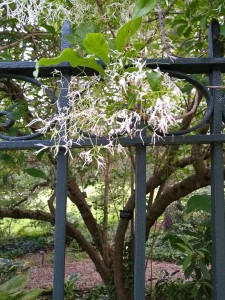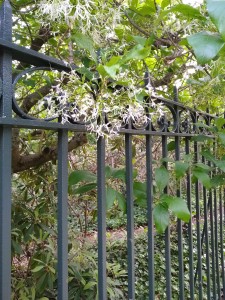 In spring you notice all the flowering trees that have been hiding in plain sight for the rest of the year. Right now, the striking Kousa dogwoods or Cornus kousa, are strutting their stuff, with large, white, four-petaled flowers that boast green centers. The trees are anonymous to all but their most loyal followers three seasons of the year, but now they are in their glory.
In spring you notice all the flowering trees that have been hiding in plain sight for the rest of the year. Right now, the striking Kousa dogwoods or Cornus kousa, are strutting their stuff, with large, white, four-petaled flowers that boast green centers. The trees are anonymous to all but their most loyal followers three seasons of the year, but now they are in their glory.
The same is true of fringe tree, either the native species, Chionanthus virginicus, or its Asian relative, Chionanthus retusus. Both are members of the olive of Oleaceae family and can be grown as large shrubs or small trees. I prefer the small tree form, because I think it works better in many landscape settings. Either way, in spring every year, fringe trees produce large clusters of fragrant flowers in such profusion that the trees look like they are completely covered with frilly white fringe. The effect is dramatic and noticed by humans and the pollinating insects that frequent both species.
Let’s start with the native fringe tree, Chionanthus virginicus. Like so many distinctive plants, it has picked up a host of evocative nicknames over the years, including “white fringe tree”, “Grancy Gray-beard”, “lace tree”, and “old-man’s beard”. The Latin name, “Chionanthus” means “white-flowered. The “chion” part also shows up in the spring-blooming Chionodoxa or “glory of the snow”, in reference to the white parts of the flowers. “Virginicus” means, logically, “native to Virginia”. In fact the trees are native to much of the American east coast.
Native fringe trees grow 12 to 20 feet, with an equal spread. They are relatively slow growers, reaching eight to ten feet tall in ten years. The bark is a smooth grayish color on the young trees, with furrows developing as the specimens mature. It is comforting to know that we all develop furrows as we age.
Once the fringe tree flowers leave the scene, the trees develop dark blue fruits that are about one half inch long. These are pretty much hidden by the leaves, unless you are one of the birds that seek them out.
Those leaves are elongated ovals that often have the lustrous mid-green color that you find on other members of the olive family, like the familiar tea olive. In the fall, the leaves depart, but not before turning yellow—occasionally brilliant yellow—as a final hurrah.
Plant authorities praise the American fringe tree. Woody plant guru, Dr. Michael Dirr, in his Manual of Woody Landscape Plants, says, “I would like to make a case for this as the national shrub, for even dogwood does not carry itself with such refinement, dignity and class when in flower;…” He goes on to recommend fringe tree for use as a specimen plant, ornamental groupings, landscaping around commercial and residential buildings, and, especially for use in cities. Among the tree’s other good qualities, it is highly pollution tolerant. While fringe trees like consistent moisture, they are also immune to the toxins emitted by black walnut roots and don’t mind the kind of clay soil that causes some species to curl up and die.
Native fringe trees do need some amount of winter cold to perform well. If you live in an area not blessed with any cold weather, try the Chinese fringe tree instead.
The Chinese fringe tree, Chionanthus retusus is very similar to its American relative, but blooms earlier in the spring and is more tolerant of summer heat. Some of the Chinese varieties also feature polished brown bark that is very attractive and adds seasonal interest when the trees are not in flower.
Many gardens and streetscapes would benefit from a small ornamental tree like fringe tree. If your municipality has a shade tree commission or similar group that regulates planting of street trees, check before installing any new tree.
American fringe trees are available at better nurseries and garden centers, particularly those that carry the Monrovia line. To find a local Monrovia retailer, go to https://www.monrovia.com/find-a-garden-center/. Call the local retailer first, as not all of them carry all plants offered by Monrovia. You can also order the American species from Wilson Bros., 1759 McGarity Road, McDonough, GA. 30252; (770) 573-1778; www.wilsonbrosgardens.com.
Buy Chionanthus retusus, the Chinese fringe tree, at ForestFarm, 14643 Watergap Rd. Williams, OR 97544; (541) 846-7269; www.forestfarm.com. Free print catalog.
